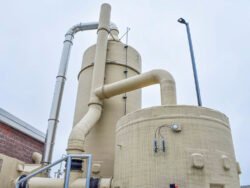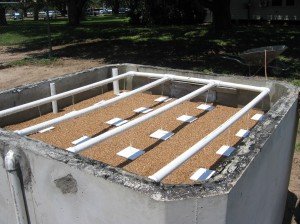Primary Clarifiers in Wastewater: Understanding Their Role in Treatment Processes

Primary clarifiers serve a critical role in wastewater treatment as they are the initial phase where solids are separated from the liquid waste. By allowing wastewater to slow down and stay in a quiescent state, these clarifiers enable heavier solids to settle at the bottom, while lighter materials like oils and grease rise to the top. This process effectively reduces the burden on subsequent treatment stages by removing a significant amount of the suspended solids from the wastewater.
The design and operational specifics of primary clarifiers may vary, but they all follow the same basic principle of gravity separation. Beyond their primary function of physical waste separation, these systems also help in the reduction of organic load entering the secondary treatment process, thus minimizing the treatment plant’s overall energy consumption and improving the efficiency of the biological treatment processes that follow.
Key Takeaways
- Primary clarifiers are an essential first step in wastewater treatment, facilitating the removal of solids.
- They operate on the principle of gravity separation to enhance the effectiveness of subsequent treatment stages.
- The efficiency of primary clarifiers impacts the energy consumption and overall performance of wastewater treatment plants.
Types of Primary Clarifiers
Primary clarifiers are a vital component of the wastewater treatment process, separating solids from liquids through sedimentation. They come in various designs, each tailored to specific space requirements, flow patterns, and processing capacities.
Circular Primary Clarifier
Circular primary clarifiers are commonly used in municipal wastewater treatment plants. They consist of a large, circular tank with a mechanical scraper system to collect settled solids, often referred to as sludge, from the bottom. As wastewater enters the center of the tank, solids gradually settle to the bottom due to gravity, while clarified water exits at the perimeter. The design promotes a natural circular flow, which aids in the even distribution of the settled solids. Circular designs are preferred for their compact footprint and efficient settling characteristics, making them ideal for facilities with limited space.
Rectangular Primary Clarifier
Rectangular primary clarifiers, on the other hand, have a long, narrow design. Wastewater flows horizontally through these tanks, allowing solids to settle out as the water moves from one end to the other. Rectangular clarifiers are often equipped with mechanical collectors that travel the length of the tank, pushing the settled sludge toward a hopper for removal. The longitudinal flow pattern of rectangular clarifiers is particularly suitable for installations where the available land area is elongated and narrow. They are also easier to cover for odor control purposes.
Offset Clarifiers
Offset clarifiers, also known as peripheral-feed clarifiers, are specialized circular clarifiers where the feed enters the tank near the periphery instead of the center. The offset position of the inflow allows for a more uniform distribution of the wastewater and helps improve the settling of solids by reducing turbulence. This clarifier type effectively utilizes tank volume and can handle higher hydraulic loads compared to conventional center-feed circular clarifiers. Offset clarifiers are an evolution in design to optimize performance in specific situations where the inflow characteristics or operational demands require such an adjustment in the flow dynamics.
Comparative Overview
In the context of wastewater treatment plants, clarifiers are crucial in separating solids from the liquid. This section provides a targeted evaluation of the roles and distinctions between primary and secondary clarifiers.
Primary vs. Secondary Clarifiers
Primary clarifiers are the first phase in the wastewater treatment process, focusing on the removal of suspended solids and organic matter through sedimentation. Their main goal is to reduce the load on secondary clarifiers, which deal with more refined treatment. Conventional wisdom suggests that primary clarification is not always necessary in systems such as sequencing batch reactors (SBRs), as noted in a fact sheet by the Environmental Protection Agency (EPA).
On the other hand, secondary clarifiers are integral to the biological aspect of wastewater treatment, operating after the biochemical oxidation of sewage. They aim to further purify the wastewater by allowing microorganisms and other fine particles to settle, as part of the secondary treatment stage. While primary treatment focuses on physical separation, secondary treatment involves complex biological processes to degrade organic pollutants, hence requiring secondary clarifiers for downstream processing.
Design Features
Primary clarifiers are a critical component in the wastewater treatment process, aiding in the separation of solids from liquids before the effluent moves on to secondary treatment. The design features significantly influence the efficiency and effectiveness of the solid-liquid separation. Two commonly implemented design features are Parallel Plate Settlers and Tube Settlers, which increase the clarifier’s settling area and thus, its performance.
Parallel Plate Settlers
Parallel Plate Settlers consist of inclined plates arranged in a parallel formation. This design increases the effective settling area within a smaller footprint. They work on the principle that a larger surface area will permit a larger quantity of solids to settle out of the wastewater as it flows through the spaces between the plates. The settling path of suspended particles in water is decreased, promoting a faster settlement. The design parameters for these settlers, such as plate material, angle of inclination, and spacing, are critical for achieving optimal performance.
Tube Settlers
Tube Settlers employ a similar principle but are composed of numerous small diameter tubes placed in close proximity to each other. The tubes are typically hexagonal and made from PVC or another durable, non-corrosive material. Tube Settlers improve particle agglomeration and promote effective settling by reducing the vertical distance a particle must fall to reach a settling surface. These systems are particularly effective in areas where space is at a premium, as they provide a high surface area to volume ratio. They are often used to upgrade existing clarifiers to increase capacity or improve effluent quality without the need for additional footprint.
Operational Principles
Primary clarifiers in wastewater treatment play an essential role, operating on the principle of gravity separation. Wastewater enters the primary clarifier tank, and the flow speed is reduced to facilitate the settling of solids. These tanks are designed to provide a quiescent area where solids can separate from the liquid phase. As a result, heavier solids descend to the bottom forming a layer of sludge, while lighter materials like oils and greases rise to the surface, forming scum.
The function of the primary clarifier is thus twofold: removal of settleable organic and inorganic solids by sedimentation, and the removal of materials that float. Here’s how it generally works:
- Sedimentation: Settleable solids sink by gravity and collect at the bottom.
- Scum Formation: Fats, oils, and greases rise to the surface.
The primary clarifier’s design includes mechanical components to continually remove these collected materials:
- For sludge: A raked bottom moves settled solids towards a hopper for removal.
- For scum: A rotating skimmer removes floatables from the surface.
| Function | Mechanism | Purpose |
|---|---|---|
| Sedimentation | Gravity settling | Solids removal |
| Scum formation | Flotation | Remove floatables |
| Sludge removal | Mechanical rakes | Collect and extract solids |
| Scum removal | Rotating skimmers | Skim and extract scum |
The primary clarifier purpose is to enhance the efficiency of the subsequent biological treatment processes. By reducing the burden of solids in the incoming wastewater, the primary clarifiers make it easier for the biological treatment components to handle the organic material without being overwhelmed by excess sediment. These operational principles ensure the effective stabilization of influent wastewater, preparing it for further treatment stages.
Performance Metrics
The effectiveness of a primary clarifier in wastewater treatment is commonly evaluated through specific performance metrics. Key among these is the removal efficiency, which reflects the clarifier’s ability to reduce suspended solids and organic load from the incoming wastewater stream.
- Total Suspended Solids (TSS) Removal:
- Typically measured in percentage reduction.
- The target is often set at a regulatory threshold or as designed.
- Biochemical Oxygen Demand (BOD) Removal:
- An indicator of the organic material present.
- Efficiency is important for reducing downstream biological treatment loads.
It’s essential for operators to routinely monitor and record data on the influent and effluent quality to determine these efficiencies. Compliance with regulatory standards is pivotal, and these metrics serve as a benchmark for the performance of the clarifier.
| Metric | Target Efficiency |
|---|---|
| Total Suspended Solids (TSS) | Varies based on regulations |
| Biochemical Oxygen Demand (BOD) | Generally >60% |
The performance is influenced by the clarifier design, hydraulic loading rates, detention time, and the characteristics of the wastewater itself. Unexpected variations in removal rates can signal the need for maintenance or adjustments in operation. Consistent monitoring not only ensures regulatory compliance but also guides operational improvements.
Operators also assess sludge volume and its settling characteristics, often using a sludge volume index (SVI) to aid in understanding the clarifier’s performance. A well-functioning primary clarifier is a cornerstone of an efficient wastewater treatment plant, setting the stage for subsequent treatment processes.
Troubleshooting and Maintenance
When maintaining primary clarifiers, operators must observe for common issues such as floating sludge. Floating sludge is often identified by a layer of solids on the water surface, which can lead to odors and poor effluent quality.
Common Issues and Solutions
- Floating Sludge: If floating sludge is noticed, it’s essential to adjust the sludge removal rate. This often involves checking and modifying the rake arm speed or ensuring proper return sludge pump operation.
- Poor Settling: Evaluate the influent for changes in load and composition. Adjusting the feed rate can improve settling characteristics.
Preventative Measures
- Regular Inspections: Carry out daily observations of the clarifier’s performance, looking for any irregularities in sludge settling or removal.
- Cleaning Regimes: Implement routine scum and sludge removal to prevent buildup that can hamper clarifier function.
Operational Checks
- Monitor sludge depth and establish a regular sludge removal schedule to prevent excessive accumulation.
- Ensure all mechanical components, like scraper arms and skimmers, are functioning properly and regularly serviced to avoid downtime.
Documentation
Maintaining accurate records of maintenance and operational adjustments assists in identifying patterns that can lead to proactive interventions, rather than reactive measures. This includes tracking sludge volumes and removal rates over time.
In all aspects of troubleshooting and maintenance, operators should adhere to guidelines such as those provided by the US EPA for municipal wastewater systems to ensure compliance and optimal performance.
Frequently Asked Questions
What are the different types of clarifiers used in water treatment processes?
There are several types of clarifiers, including circular and rectangular primary clarifiers, used in water treatment. Circular clarifiers are common in compact plants, while rectangular ones are often found in larger installations.
How do primary clarifiers function within a wastewater treatment plant?
Primary clarifiers serve to remove solids, oils, and other materials by allowing them to settle out from the sewage due to gravity. The process is a physical one, providing preliminary treatment before biological stages.
What are the common issues encountered with primary clarifiers in wastewater treatment?
Common issues include sludge buildup, scum accumulation, and ineffective settling which can hinder performance. Ensuring proper flow rates and turbulence control can help mitigate these problems.
In what ways do primary clarifiers differ from secondary clarifiers?
Primary clarifiers primarily remove settleable and floating solids, whereas secondary clarifiers further reduce the organic content of the wastewater through biological processes.
What steps are involved in the maintenance of primary clarifiers to ensure efficient operation?
Maintenance involves routine removal of sludge and scum, inspection for wear and tear, and ensuring the mechanisms for settling and skimming are functioning properly. Regular cleaning is also integral to performance.
Could you detail the process that occurs when sewage enters a primary clarifier?
When sewage enters a primary clarifier, solids settle to the bottom to form sludge, while lighter materials float to the top, forming scum. Both are then removed and the somewhat clarified water proceeds to the next treatment phase.


